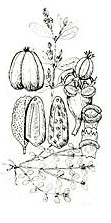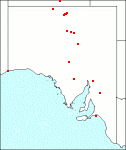Family: Euphorbiaceae
Euphorbia drummondii
Citation:
Boiss., Cent. Euph. 14 (1860).
Synonymy: Chamaesyce australis (Boiss.)Hassall, Aust. J. Bot. 24:640 (1976).
Common name: Caustic weed, flat spurge, caustic creeper, creeping caustic, mat-spurge, milkweed.
Description:
Much-branched glabrous prostrate annual or short-lived perennial herb, grey-green often a bluish grey-green sometimes with reddish stems to 30 cm long, at length woody basally, arising from an often woody tap root, often swollen at the nodes to appear articulate; leaves opposite, subsessile, ovate or ovate-oblong to suborbicular, 4-8 x 1.5-3 mm, obtuse or notched, asymmetrical at the base, entire or minutely serrulate along the summit, green to glaucous, tinted slightly red all over or only on the margins; stipules entire, fringed or filiformly lobed, to 0.7 mm long, free or interpetiolar, white to pink.
cyathia funnel-shaped, on short peduncles to 0.5 mm long, single in upper axils or terminally on very short branchlets supported by 2 raylet-leaves exceeding the cyathia; involucres c. 1 mm long, green to red; glands reniform, c. 0.3 mm long, red, with a rarely deeply divided petaloid and pink or white or circular and more or less entire appendage or the appendage more or less obsolete or absent; styles short, thick, ascending, divided to the middle.
capsule subglobose, 3-lobed, 1.5-2 mm across, glabrous; seed quadrangular-oblong, c. 1.2 mm long, apiculate, smooth to more or less rugulose between the ribs, white to pink or brown, acarunculate.

| Euphorbia drummondii habit, twig, leaf, cyathium, gland, fruit and seeds.
|
Image source: fig 401e in Jessop J.P. & Toelken H.R. (Ed.) 1986. Flora of South Australia (4th edn).
|
Published illustration:
Bailey (1906) The weeds and suspected poisonous plants of Queensland, t. 23 & 24; Everist (1974) Poisonous plants of Australia, pl. 21; Cunningham et al. (1982) Plants of western New South Wales, p. 455.
|
|
Distribution:
|
Frequent on a wide range of soil types in numerous vegetation communities, often as a weed of disturbed areas.
|
Conservation status:
native
Flowering time: most of the year.
|

SA Distribution Map based
on current data relating to
specimens held in the
State Herbarium of South Australia
|
Biology:
Used medicinally by Aboriginals; poisonous effects to stock uncertain (Everist (1974) Poisonous plants of Australia, p. 265).
Taxonomic notes:
A very variable species in size, habit and habitat. The seed length is constant, but the ornamentation on the testa may vary greatly from smooth to rugulose when it resembles E. wheeleri which has larger seed. Appendages are usually absent from northern specimens, while in FR some have them well developed, deeply divided and pink to red. Plants with red stems and glaucous leaves may resemble E. inappendiculata which is papillose.
Author:
Not yet available
|

